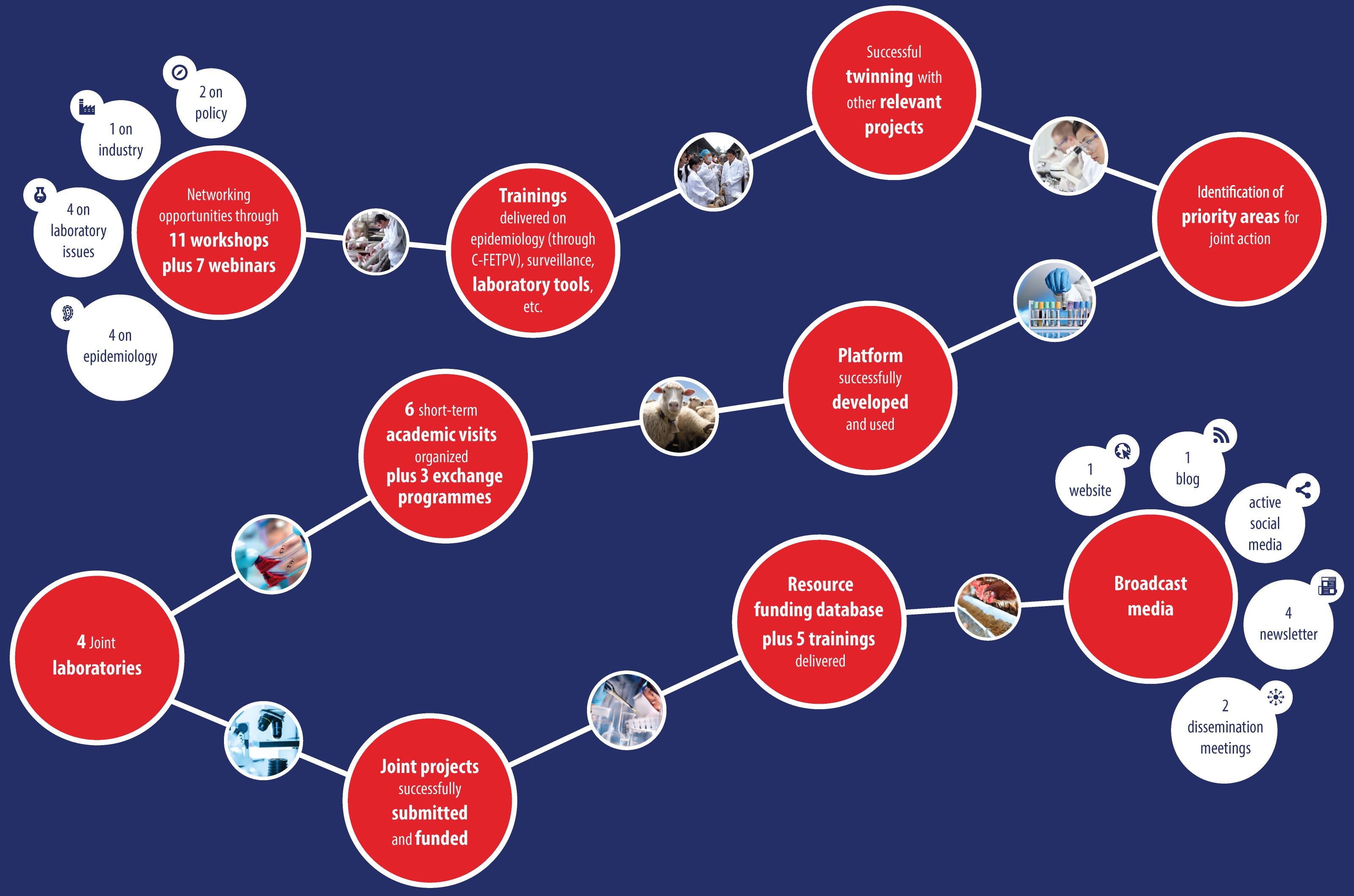Results
The LinkTADs project has allowed for the generation of presentations, reports, brochures, and flyers, as well as for the organisation of specific deliverables such as meetings, exchanges, and projects. A summary of LinkTADs' achievements is provided in the diagram below. A variety of collaboration tools such as networking opportunities, trainings, academic visits, workshops, and webinars are only a few of the highlights from specific work packages which contribute to the ongoing legacy of the LinkTADs project.
Animal health priorities and gaps identified - namely African swine fever (ASF), antimicrobial resistance (AMR), avian influenza, bovine tuberculosis (bTB), classical swine fever (CSF), Japanese encephalitis (JE), peste des petits ruminants (PPR), and porcine reproductive and respiratory syndrome (PRRS),
11 technical workshops organized - The wide variety of topics of the workshops were chosen in alignment with the priorities and gaps identified at the beginning of the project. Covering epidemiology, laboratory, and policy aspects, internationally renowned experts were invited to present and participate along with LinkTADs partners. This provided excellent opportunities to learn more about the research being conducted at different institutions, identify common interests, and start exploring face-to-face potential pathways and topics of collaborations.
6 short academic visits and 3 exchange programs organized – LinkTADs set aside funds for LinkTADs associates to visit partner institutions, thus having the time to visit each other’s laboratories and facilities, learn in depth about activities and research lines, meet all researchers at the recipient institution (not just those directly involved in LinkTADs), and sit together and discuss the best methods for collaboration.
7 webinars broadcasted - Also based on the interests of partners, a series of webinars were organized covering mostly specific diseases or policy aspects. A hybrid between dissemination and training, this modern tool was seen as a very useful way to deliver talks by experts allowing a wide participation of stakeholders in the EU/China, especially those who cannot physically participate in the project workshops. Moreover, the webinar recordings and presentations were made available online afterwards. Webinars usually lasted between one and two hours and always included a question and answer session.
5 trainings delivered - The training component of LinkTADs was closely aligned with the China Field Epidemiology Training Program for Veterinarians (China FETPV), an interdisciplinary (One Health) approach that has been highly successful in building up field epidemiology capacity in a highly interactive and sustainable way. In addition, LinkTADs partners were sponsored to participate in specific sessions at the InterRisk Master, and a one month online course on foot-and-mouth disease was exclusively delivered by the European Commission for the control of foot-and-mouth disease (EuFMD) to 40 Chinese veterinarians in different institutions.
Successful twinning with 6 other EC-funded consortia – During its lifetime, LinkTADs has actively interacted with six other EU-funded consortia: STAR-IDAZ, ASFORCE, RISKSUR, EFFORT, RAPIDIA and COMPARE. Such collaborations have been mostly through the joint organization of events, as well as inviting experts from the other consortia to attend LinkTADs workshops.
Web-based platform successfully developed and updated – We would highly encouraged all those interested in research in China and the EU to visit our website and 1) consult the database of over 100 funding programmes for international researchers focusing on EU-China research collaboration; 2) check the collection of EU-China policy and strategy documents in animal health research collaboration; 3) access the Focal Point Network of epidemiology and laboratory research experts in the EU and China; 4) download workshop reports, recorded webinars, past newsletters and training materials; and 5) search on our partner database.
Continuous dissemination through all media - All along the project, we have made use of all major social media to reach researchers, i.e. facebook, (113 likes), LinkedIn page 1250 connections and 193 group members), Twitter (469 followers, >1697 tweets), weibo (95 posts, 46 followers). In addition, we have published 4 newsletters, and have organized 5 dissemination events jointly with major scientific conferences.

